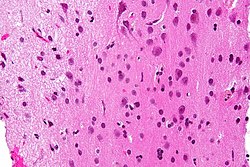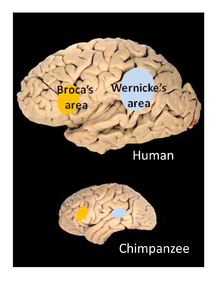| Vascular dementia | |
|---|---|
| Other names | Arteriosclerotic dementia (in the ICD-9) Multi-infarct dementia (in the ICD-10) Vascular cognitive impairment |
| Specialty | Psychiatry, neurology |
Vascular dementia (VaD) is dementia caused by problems in the supply of blood to the brain, typically a series of minor strokes, leading to worsening cognitive decline that occurs step by step. The term refers to a syndrome consisting of a complex interaction of cerebrovascular disease and risk factors that lead to changes in the brain structures due to strokes and lesions, and resulting changes in cognition. The temporal relationship between a stroke and cognitive deficits is needed to make the diagnosis.
Signs and symptoms
Differentiating
dementia syndromes can be challenging, due to the frequently
overlapping clinical features and related underlying pathology. In
particular, Alzheimer's dementia often co-occurs with vascular dementia.
People with vascular dementia present with progressive cognitive impairment, acutely or subacutely as in mild cognitive impairment,
frequently step-wise, after multiple cerebrovascular events (strokes).
Some people may appear to improve between events and decline after
further silent strokes. A rapidly deteriorating condition may lead to
death from a stroke, heart disease, or infection.
Signs and symptoms are cognitive, motor, behavioral, and for a significant proportion of patients also affective. These changes typically occur over a period of 5–10 years. Signs are typically the same as in other dementias,
but mainly include cognitive decline and memory impairment of
sufficient severity as to interfere with activities of daily living,
sometimes with presence of focal neurologic signs, and evidence of
features consistent with cerebrovascular disease on brain imaging (CT or
MRI). The neurologic signs localizing to certain areas of the brain that can be observed are hemiparesis, bradykinesia, hyperreflexia, extensor plantar reflexes, ataxia, pseudobulbar palsy, as well as gait problems and swallowing difficulties. People have patchy deficits in terms of cognitive testing. They tend to have better free recall and fewer recall intrusions when compared with patients with Alzheimer's disease. In the more severely affected patients, or patients affected by infarcts in Wernicke's or Broca's areas, specific problems with speaking called dysarthrias and aphasias may be present.
In small vessel disease,
the frontal lobes are often affected. Consequently, patients with
vascular dementia tend to perform worse than their Alzheimer's disease
counterparts in frontal lobe tasks, such as verbal fluency, and may present with frontal lobe problems: apathy, abulia (lack of will or initiative), problems with attention, orientation, and urinary incontinence. They tend to exhibit more perseverative behavior. VaD patients may also present with general slowing of processing ability, difficulty shifting sets, and impairment in abstract thinking. Apathy early in the disease is more suggestive of vascular dementia.
Rare genetic disorders that cause vascular lesions in the brain
have other presentation patterns. As a rule, they tend to occur earlier
in life and have a more aggressive course. In addition, infectious
disorders, such as syphilis, can cause arterial damage, strokes, and bacterial inflammation of the brain.
Causes
Vascular dementia can be caused by ischemic or hemorrhagic infarcts affecting multiple brain areas, including the anterior cerebral artery territory, the parietal lobes, or the cingulate gyrus. On rare occasion, infarcts in the hippocampus or thalamus are the cause of dementia.
A history of stroke increases the risk of developing dementia by around
70%, and recent stroke increases the risk by around 120%. Brain vascular lesions can also be the result of diffuse cerebrovascular disease, such as small vessel disease.
Risk factors for vascular dementia include age, hypertension, smoking, hypercholesterolemia, diabetes mellitus, cardiovascular disease, and cerebrovascular disease. Other risk factors include geographic origin, genetic predisposition, and prior strokes.
Vascular dementia can sometimes be triggered by cerebral amyloid angiopathy, which involves accumulation of beta amyloid
plaques in the walls of the cerebral arteries, leading to breakdown and
rupture of the vessels. Since amyloid plaques are a characteristic
feature of Alzheimer's disease,
vascular dementia may occur as a consequence. Cerebral amyloid
angiopathy can, however, appear in people with no prior dementia
condition. Amyloid beta accumulation is often present in cognitively normal elderly people.
Two reviews of 2018 and 2019 found potentially an association between celiac disease and vascular dementia.
Diagnosis
Several specific diagnostic criteria can be used to diagnose vascular dementia, including the Diagnostic and Statistical Manual of Mental Disorders, Fourth Edition (DSM-IV) criteria, the International Classification of Diseases, Tenth Edition (ICD-10) criteria, the National Institute of Neurological Disorders and Stroke criteria, Association Internationale pour la Recherche et l'Enseignement en Neurosciences (NINDS-AIREN) criteria, the Alzheimer's Disease Diagnostic and Treatment Center criteria, and the Hachinski Ischemic Score (after Vladimir Hachinski).
The recommended investigations for cognitive impairment include:
blood tests (for anemia, vitamin deficiency, thyrotoxicosis, infection,
etc.), chest X-Ray, ECG,
and neuroimaging, preferably a scan with a functional or metabolic
sensitivity beyond a simple CT or MRI. When available as a diagnostic
tool, single photon emission computed tomography (SPECT) and positron emission tomography (PET) neuroimaging may be used to confirm a diagnosis of multi-infarct dementia in conjunction with evaluations involving mental status examination.
In a person already having dementia, SPECT appears to be superior in
differentiating multi-infarct dementia from Alzheimer's disease,
compared to the usual mental testing and medical history analysis. Advances have led to the proposal of new diagnostic criteria.
The screening blood tests typically include full blood count, liver function tests, thyroid function tests, lipid profile, erythrocyte sedimentation rate, C reactive protein, syphilis serology, calcium serum level, fasting glucose, urea, electrolytes, vitamin B-12, and folate. In selected patients, HIV serology and certain autoantibody testing may be done.
Mixed dementia is diagnosed when people have evidence of Alzheimer's disease and cerebrovascular disease, either clinically or based on neuro-imaging evidence of ischemic lesions.
Pathology
Gross
examination of the brain may reveal noticeable lesions and damage to
blood vessels. Accumulation of various substances such as lipid deposits
and clotted blood appear on microscopic views. The white matter
is most affected, with noticeable atrophy (tissue loss), in addition to
calcification of the arteries. Microinfarcts may also be present in the
gray matter (cerebral cortex), sometimes in large numbers.
Although atheroma of the major cerebral arteries is typical in vascular dementia, smaller vessels and arterioles are mainly affected.
Prevention
Early detection and accurate diagnosis are important, as vascular dementia is at least partially preventable. Ischemic changes in the brain are irreversible, but the patient with vascular dementia can demonstrate periods of stability or even mild improvement. Since stroke is an essential part of vascular dementia, the goal is to prevent new strokes. This is attempted through reduction of stroke risk factors, such as high blood pressure, high blood lipid levels, atrial fibrillation, or diabetes mellitus.
Meta-analyses have found that medications for high blood pressure are
effective at prevention of pre-stroke dementia, which means that high
blood pressure treatment should be started early. These medications include angiotensin converting enzyme inhibitors, diuretics, calcium channel blockers, sympathetic nerve inhibitors, angiotensin II receptor antagonists or adrenergic antagonists. Elevated lipid levels, including HDL, were found to increase risk of vascular dementia. However, six large recent reviews showed that therapy with statin drugs was ineffective in treatment or prevention of this dementia. Aspirin
is a medication that is commonly prescribed for prevention of strokes
and heart attacks; it is also frequently given to patients with
dementia. However, its efficacy in slowing progression of dementia or
improving cognition has not been supported by studies.
Smoking cessation and Mediterranean diet have not been found to help
patients with cognitive impairment; physical activity was consistently
the most effective method of preventing cognitive decline.
Treatment
Currently,
there are no medications that have been approved specifically for
prevention or treatment of vascular dementia. The use of medications for
treatment of Alzheimer's dementia, such as cholinesterase inhibitors and memantine, has shown small
improvement of cognition in vascular dementia. This is most likely due
to the drugs' actions on co-existing AD-related pathology. Multiple
studies found a small benefit in VaD treatment with: memantine, a non-competitive N-methyl-D-aspartate (NMDA) receptor antagonist; cholinesterase inhibitors galantamine, donepezil, rivastigmine; and ginkgo biloba extract.
In those with celiac disease or non-celiac gluten sensitivity, a strict gluten-free diet may relieve symptoms of mild cognitive impairment.
It should be started as soon as possible. There is no evidence that a
gluten free diet is useful against advanced dementia. People with no
digestive symptoms are less likely to receive early diagnosis and
treatment.
General management of dementia includes referral to community
services, aid with judgment and decision-making regarding legal and
ethical issues (e.g., driving, capacity, advance directives), and
consideration of caregiver stress.
Behavioral and affective symptoms deserve special consideration in this
patient group. These problems tend to resist conventional
psychopharmacological treatment, and often lead to hospital admission
and placement in permanent care.
Prognosis
Many
studies have been conducted to determine average survival of patients
with dementia. The studies were frequently small and limited, which
caused contradictory results in the connection of mortality to the type
of dementia and the patient's gender. A very large study conducted in
Netherlands in 2015 found that the one-year mortality was three to four
times higher in patients after their first referral to a day clinic for
dementia, when compared to the general population. If the patient was hospitalized for dementia, the mortality was even higher than in patients hospitalized for cardiovascular disease. Vascular dementia was found to have either comparable or worse survival rates when compared to Alzheimer's Disease; another very large 2014 Swedish study found that the prognosis for VaD patients was worse for male and older patients.
Unlike Alzheimer's Disease, which weakens the patient, causing them to succumb to bacterial infections like pneumonia, vascular dementia can be a direct cause of death due to the possibility of a fatal interruption in the brain's blood supply.
Epidemiology
Vascular dementia is the second-most-common form of dementia after Alzheimer's disease (AD) in older adults. The prevalence
of the illness is 1.5% in Western countries and approximately 2.2% in
Japan. It accounts for 50% of all dementias in Japan, 20% to 40% in
Europe and 15% in Latin America. 25% of stroke patients develop
new-onset dementia within one year of their stroke. One study found that
in the United States, the prevalence of vascular dementia in all people
over the age of 71 is 2.43%, and another found that the prevalence of
the dementias doubles with every 5.1 years of age. The incidence peaks between the fourth and the seventh decades of life and 80% of patients have a history of hypertension.
A recent meta-analysis identified 36 studies of prevalent stroke
(1.9 million participants) and 12 studies of incident stroke (1.3
million participants). For prevalent stroke, the pooled hazard ratio for all-cause dementia was 1.69 (95% confidence interval: 1.49–1.92; P < .00001; I2 = 87%). For incident stroke, the pooled risk ratio was 2.18 (95% confidence interval: 1.90–2.50; P < .00001; I2
= 88%). Study characteristics did not modify these associations, with
the exception of sex, which explained 50.2% of between-study
heterogeneity for prevalent stroke. These results confirm that stroke is
a strong, independent, and potentially modifiable risk factor for
all-cause dementia.







